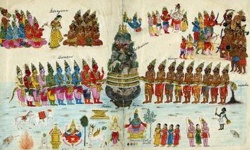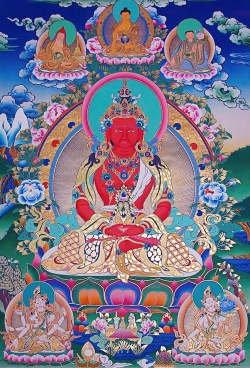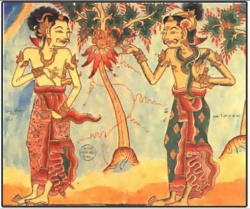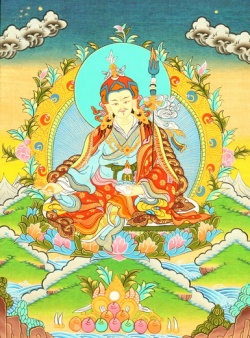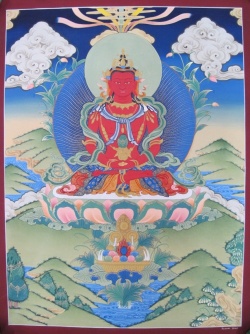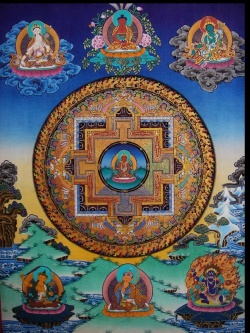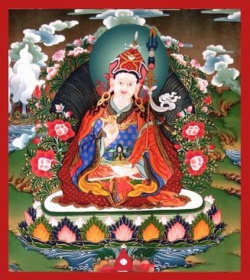The Thirty-one Planes of Existence
Scattered throughout the suttas are references to as many as thirty-one distinct "planes" or "realms" of existence into which beings can be reborn during their long wandering through samsara.
These range from the extraordinarily grim and painful hell realms all the way up to the most exquisitely refined and blissful heaven realms.
Existence in every realm is temporary; in Buddhist cosmology there is no eternal heaven or hell. Beings are born into a particular realm according to their past kamma.
When they pass away, they take rebirth once again elsewhere according to the quality of their kamma: wholesome actions bring about a favorable rebirth, while unwholesome actions lead to an unfavorable one. And so the wearisome cycle continues.
The realms of existence are customarily divided into three distinct "worlds" (Loka), listed here in descending order of refinement:
- The Immaterial world (arupa)]-loka). Consists of four realms that are accessible to those who pass away while meditating in the formless jhanas.
- The Fine-Material world (rupa-loka). Consists of sixteen realms whose inhabitants (the devas) experience extremely refined degrees of mental pleasure.
These realms are accessible to those who have attained at least some level of Jhana and who have thereby managed to (temporarily) suppress hatred and ill-will. They are said to possess extremely refined bodies of pure Light.
The highest of these realms, the Pure Abodes, are accessible only to those who have attained to "non-returning," the third stage of Awakening.
The Fine-Material World and the Immaterial World together constitute the "heavens" (sagga).
- The Sensuous world (Kama-Loka). Consists of eleven realms in which experience — both pleasurable and not — is dominated by the five senses.
Seven of these realms are favorable destinations, and include our own Human realm as well as several realms occupied by devas. The lowest realms are the four "bad" destinations, which include the animal and hell realm's.
The Information on this page was assembled from a variety of sources. In the interests of economizing space I have not attributed each fact to its respective source.
I. The Immaterial World (arupa-loka)
| Realm | Comments | Cause of rebirth here |
|---|---|---|
| (31) Neither-perception-nor-non-perception (nevasaññanasaññayatanupaga deva) |
The inhabitants of these realms are possessed entirely of mind. Having no physical body, they are unable to hear Dhamma teachings. |
Fourth formless jhana |
| (30) Nothingness (akiñcaññayatanupaga deva) |
Third formless jhana | |
| (29) Infinite Consciousness (viññanañcayatanupaga deva) |
Second formless jhana | |
| (28) Infinite Space (akasanañcayatanupaga deva) |
First formless jhana |
II. The Fine-Material World (rupa-loka)
III. The Sensuous World (kama-loka)
Happy Destinations (sugati)
| Realm | Comments | Cause of rebirth here |
|---|---|---|
| (11) Devas Wielding Power over the Creation of Others (paranimmita-vasavatti deva) |
These devas enjoy sense pleasures created by others for them. Mara, the personification of delusion and desire, lives here. |
|
| (10) Devas Delighting in Creation (nimmanarati deva) |
These devas delight in the sense objects of their own creation. | |
| (9) Contented devas (tusita deva) |
A realm of pure delight and gaiety. Bodhisattas abide here prior to their final human birth. This is where the bodhisatta Maitreya (Metteya), the next Buddha, is said to dwell. | |
| (8) Yama devas (yama deva) |
These devas live in the air, free of all difficulties. | |
| (7) The Thirty-three Gods (tavatimsa deva) |
Sakka, a devotee of the Buddha, presides over this realm. Many devas dwelling here live in mansions in the air. | |
| (6) Devas of the Four Great Kings (catumaharajika deva) |
Home of the gandhabbas, the celestial musicians, and the yakkhas, tree spirits of varying degrees of ethical purity. The latter are analogous to the goblins, trolls, and fairies of Western fairy tales. | |
| (5) Human beings (manussa loka) | You are here (for now).
Rebirth as a human being is |
|
States of Deprivation (apaya)
| Realm | Comments | Cause of rebirth here |
|---|---|---|
| (4) Asuras (asura) | The demons — "titans" — that dwell here are engaged in relentless conflict with each other. · |
Ten unwholesome actions (MN 41) |
| (3) Hungry Shades/Ghosts (peta loka) |
Ghosts and unhappy spirits wander hopelessly about this realm, searching in vain for sensual fulfillment. Read Ajaan Lee's colorful description |
|
| (2) Animals (tiracchana yoni) |
This realm includes all the non-human forms of life that are visible to us under ordinary circumstances: animals, insects, fish, birds, worms, etc. |
|
| (1) Hell (niraya) | These are realms of unimaginable suffering and anguish (described in graphic detail in MN 129 and MN 130). Should not be confused with the eternal hell found in other religious traditions, since one's time here is — as it is in every realm — temporary. |
|
Sources:
- Buddhist Dictionary, by Nyanatiloka Mahathera (Kandy: Buddhist Publication Society, 1980).
- The Buddhist Religion: A Historical Introduction (fourth edition), by R.H. Robinson & W.L. Johnson (Belmont, California: Wadsworth, 1997).
- The Long Discourses of the Buddha (Introduction), translated by Maurice Walshe (Boston: Wisdom Publications, 1987).
- A Manual of Abhidhamma, by Ven. Narada Thera (Kuala Lumpur: Buddhist Missionary Society, 1979).
- The Middle Length Discourses of the Buddha (Introduction), translated by Bhikkhu Ñanamoli and Bhikkhu Bodhi (Boston: Wisdom Publications, 1995).
- Teacher of the Devas (Wheel Publication 414/416), by Susan Elbaum Jootla (Kandy: Buddhist Publication Society, 1997).
- The Three Worlds (wall chart), compiled by Ven. Acaro Suvanno (printed for free distribution by devotees and Mr & Mrs Lim Say Hoe and family).
Source
"The Thirty-one Planes of Existence", edited by Access to Insight]. Access to Insight, 29 August 2012, http://www.accesstoinsight.org/ptf/dhamma/sagga/loka.html . Retrieved on 5 April 2013.
